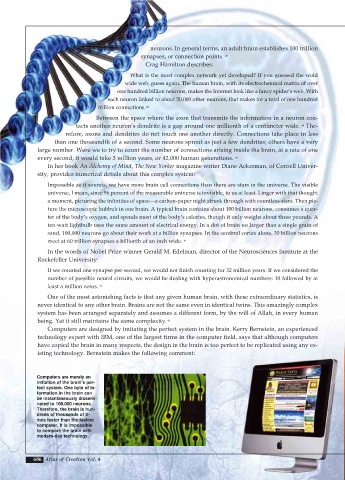Page 688 - Atlas of Creation Volume 4
P. 688
neu rons. In gen er al terms, an adult brain es tab lish es 100 tril lion
syn ap ses, or con nec tion points. 87
Crag Hamilton de scribes:
What is the most com plex net work yet de vel oped? If you guessed the wold
wide web, guess again. The hu man brain, with its elec tro chem i cal ma trix of over
one hun dred bil lion neu rons, makes the Internet look like a fan cy spi der’s web. With
each neu ron linked to about 50,000 oth er neu rons, that makes for a to tal of one hun dred
tril lion con nec tions. 88
Between the space where the ax on that trans mits the in for ma tion in a neu ron con-
tacts an oth er neu ron’s den drite is a gap around one mil lionth of a cen ti me ter wide. The-
89
refore, ax ons and den drites do not touch one an oth er di rect ly. Connections take place in less
than one thou sandth of a sec ond. Some neu rons sprout as just a few den drites; oth ers have a very
large num ber. Were we to try to count the num ber of con nec tions aris ing in side the brain, at a rate of one
ev ery sec ond, it would take 3 mil lion years, or 42,000 hu man gen er a tions. 90
In her book An Alchemy of Mind, The New Yorker mag a zine writer Diane Ackerman, of Cornell Univer-
sity, pro vides nu mer i cal de tails about this com plex sys tem:
Impossible as it sounds, we have more brain cell con nec tions than there are stars in the uni verse. The vis i ble
uni verse, I mean, since 96 per cent of the meas ur a ble uni verse is in vis i ble, to us at least. Linger with that thought
a mo ment, pic tur ing the in fin i ties of space—a car bon-pa per night struck through with count less stars. Then pic -
ture the mi cro scop ic hub bub in one brain. A typ i cal brain con tains about 100 bil lion neu rons, con sumes a quar -
ter of the body’s ox y gen, and spends most of the body’s cal o ries, though it on ly weighs about three pounds. A
ten-watt light bulb us es the same amount of elec tri cal en er gy. In a dot of brain no larg er than a sin gle grain of
sand, 100,000 neu rons go about their work at a bil lion syn ap ses. In the ce re bral cor tex alone, 30 bil lion neu rons
meet at 60 tril lion syn apses a bil lionth of an inch wide. 91
In the words of Nobel Prize winner Gerald M. Edelman, director of the Neurosciences Institute at the
Rockefeller University:
If we count ed one syn apse per sec ond, we would not fin ish count ing for 32 mil lion years. If we con sid ered the
num ber of pos si ble neu ral cir cuits, we would be deal ing with hy per as tro nom i cal num bers: 10 fol lowed by at
least a mil lion ze ros. 92
One of the most as ton ish ing facts is that any giv en hu man brain, with these ex traor di na ry sta tis tics, is
nev er iden ti cal to any oth er brain. Brains are not the same even in iden ti cal twins. This amaz ing ly com plex
sys tem has been ar ranged sep a rate ly and as sumes a dif fer ent form, by the will of Allah, in ev ery hu man
be ing. Yet it still main tains the same com plex i ty. 93
Computers are de signed by im i tat ing the per fect sys tem in the brain. Kerry Bernstein, an ex pe ri enced
tech nol o gy ex pert with IBM, one of the larg est firms in the com put er field, says that al though com put ers
have cop ied the brain in many re spects, the de sign in the brain is too per fect to be rep li cat ed us ing any ex -
ist ing tech nol o gy. Bernstein makes the fol low ing com ment:
Computers are merely an
imitation of the brain’s per-
fect system. One byte of in-
formation in the brain can
be instantaneously dissemi-
nated to 100,000 neurons.
Therefore, the brain is hun-
dreds of thousands of ti-
mes faster than the fastest
computer. It is impossible
to compare the brain with
modern-day technology.
686 Atlas of Creation Vol. 4

